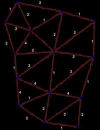Roger Penrose first proposed Twistor theory in 1967, with the intention of unifying general relativity and quantum mechanics into a theory of Quantum Gravity. It is based on projective geometry and an area of mathematics known as integral geometry. Twistors are complex objects like wavefunctions in quantum mechanics. Penrose maps objects in conventional four dimensional space-time into objects into a space with four complex dimensions; complex in the mathematical sense of using complex numbers. The space is called Twistor Space, and points in this space, represented by complex coordinates, are the Twistors themselves. Edward Witten proposed a connection between string theory and twistor geometry that he called twistor string theory. He proposed a way to look at string theory within twistor space, as a way to eliminate the multiple dimensions of space required in Superstring and "M" theory. However, to quote Witten, "I think twistor string theory is something that only partly works", so we will have to wait and see. Another proposal was to use "super twistor space", a supersymmetric extension of Penrose's original twistor space. As of June 2010, string theorists have started to look again at twistors. We have yet to hear whether any fruitful results are forthcoming.
Penrose also has strong views on what he regards as the failure of Quantum mechanics. This is called the "Penrose Interpretation", which seems to be based loosely on objective collapse theory. These theories are at odds with any of the "many Worlds" theories, as they use the collapse of the wave function to circumvent the question of unobserved behavior. While the Penrose Interpretation, and other objective theories, are similar to the Copenhagen Interpretation, they differ in one significant way; they treat the wave function as, essentially, "real". The collapse of the wave function, however, occurs randomly, or at least with no special reference to any observer.
Now for a few more links that provide more information on this complicated and highly mathematical theory. Here is an introduction to Twistor Theory by Andrew Hodges. Necessary to understanding Twistors is an understanding of Spinors, which are a component of Quantum mechanics that defines Spin; thus a spinor is a binary object taking a value of either "spin-up" or "spin-down". A spin network is a diagram showing interactions between particles and fields in quantum mechanics; see the picture to the right. Roger Penrose developed spin networks in 1971, but similar techniques had been used prior to that. They have been used in loop quantum gravity by, amongst others, Lee Smolin and Carlo Rovelli. Where spin networks describe the quantum geometry of space, spin foam describes the quantum geometry of spacetime; that is in one more dimension.
Penrose also has strong views on what he regards as the failure of Quantum mechanics. This is called the "Penrose Interpretation", which seems to be based loosely on objective collapse theory. These theories are at odds with any of the "many Worlds" theories, as they use the collapse of the wave function to circumvent the question of unobserved behavior. While the Penrose Interpretation, and other objective theories, are similar to the Copenhagen Interpretation, they differ in one significant way; they treat the wave function as, essentially, "real". The collapse of the wave function, however, occurs randomly, or at least with no special reference to any observer.
Now for a few more links that provide more information on this complicated and highly mathematical theory. Here is an introduction to Twistor Theory by Andrew Hodges. Necessary to understanding Twistors is an understanding of Spinors, which are a component of Quantum mechanics that defines Spin; thus a spinor is a binary object taking a value of either "spin-up" or "spin-down". A spin network is a diagram showing interactions between particles and fields in quantum mechanics; see the picture to the right. Roger Penrose developed spin networks in 1971, but similar techniques had been used prior to that. They have been used in loop quantum gravity by, amongst others, Lee Smolin and Carlo Rovelli. Where spin networks describe the quantum geometry of space, spin foam describes the quantum geometry of spacetime; that is in one more dimension.

Twistors & Spinors
Physics
-
Quantum Gravity
Menu:


